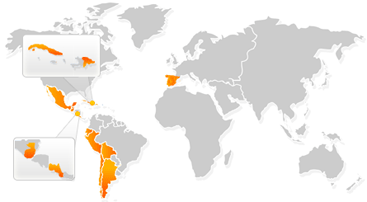Differences between Spanish Translation and Latin American Translation
Perhaps there is some confusion with regard to Spanish spoken by people in Spain and that which is used by Latin American people. There are surely many similarities as there are differences in these two languages which leads to differences between Spanish translation and Latin American translation.
Tracing back the history of the Spanish language in Latin America, there is immense influence because the language was first used by colonizers during the establishment of the New World. When Spaniards started occupying territories, Spanish was widely used, so much so that it was eventually taught in schools and became the language of most Latin American countries. Mexico is the country which has the most Spanish-speaking citizens.
Castilian Spanish – which is also known as European Spanish – is one of the dialects in the country. Owing to a larger populace that spoke it, it eventually became the national language. Of course, this is not to say that other dialects in Spain were completely disregarded. Galician, Basque and Catalan are still widely used especially in regions where these dialects are in place.
When Spaniards started colonizing many parts of the globe in pursuit of establishing the New World, Latin America was one of the nearest territories to conquer. They did colonize most parts of the continent and were able to permeate their own language, customs and traditions as well as cultural heritage to the colonized territories. The eventual use of Spanish was widespread in many parts of Latin America. And the influences stayed with the people long after the colonizers have taken aback and rerouted to their own land.
This is one element of languages – adaptability. It seeps through the people and culture where it is spoken, and adapts to these changes of the new environment. When Castilian Spanish was adapted by most Latin American people, they injected their own elements into the language which eventually distinguished it from the original source. In Mexico, for instance, they do not refer to their language as Español, but rather Castilian. Email – for electronic mail was simply e-mal, while in Castilian Spanish it is “correo electronico”.
The similarities between the Castilian Spanish and the Latin American Spanish are a lot. These are evident in the spelling, form, structure, and even the grammar of the two languages. There are slight variations and differences which are practically expected of an adapted language. Some words differ from the source language in terms of spelling and form but they still mean the same thing.
Spanish translation
Translation agencies that are working on Spanish translation are equipped with the right tools to help them use the appropriate translation elements for a particular project. Knowing if the source or target language is either in European or Castilian Spanish, or Latin American Spanish helps them to make the right translation. Some words may differ in context and meaning from Latin American Spanish or it could be similar to the Castilian Spanish, but understanding the target audience and the cultural relevance of the source or target language make translation convenient for these language companies. They tailor-fit the Spanish translation to match the market and, necessarily, convey the message as it is intended in the original text regardless if it is Castilian or Latin American Spanish.









